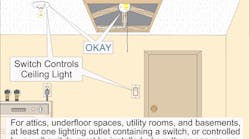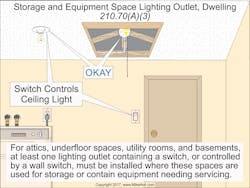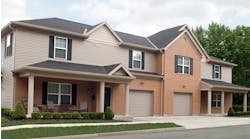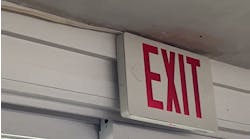Underlined text indicates a change in the rules for the 2017 NEC.
Q. What are the lighting outlet requirements for dwellings in the NEC?
Scroll Down to See the Answer
A. As outlined in Sec. 210.70(A), lighting outlets must be installed in:
(1) Habitable rooms. At least one wall switch‑controlled lighting outlet must be installed in every habitable room, kitchen, and bathroom of a dwelling unit. (See the definition of “Lighting Outlet” in Art. 100.)
Exception No. 1: In other than kitchens and bathrooms, a receptacle controlled by a wall switch can be used instead of a lighting outlet.
Exception No. 2: Lighting outlets can be controlled by occupancy sensors equipped with a manual override that permits the sensor to function as a wall switch.
The Code specifies the location of the wall switch‑controlled lighting outlet, but it doesn’t specify the switch location. Naturally, you wouldn’t want to install a switch behind a door or other inconvenient location, but the NEC doesn’t require you to relocate the switch to suit the swing of the door. When in doubt as to the best location to place a light switch, consult the job plans or ask the customer.
(2) Other than habitable rooms.
(1) Hallways, stairways, and garages. In dwelling units, not less than one wall switch‑controlled lighting outlet must be installed in hallways, stairways, and attached and detached garages with electric power.
(2) Exterior entrances. For dwelling units, attached garages, and detached garages with electric power, at least one wall switch‑controlled lighting outlet must provide illumination on the exterior side of outdoor entrances or exits with grade‑level access.
A garage vehicle door isn’t considered an outdoor entrance or exit.
The NEC doesn’t require a switch adjacent to each outdoor entrance or exit. The Code considers switch location a “design issue” which is beyond the purpose of the NEC [90.1(A)]. For this reason, proposals to mandate switch locations have been rejected.
A lighting outlet isn’t required to provide illumination on the exterior side of outdoor entrances or exits for a commercial or industrial occupancy.
(3) Stairway. Where lighting outlets are installed in interior stairways having six risers or more, a wall switch must be located at each floor level and at each landing level that includes an entryway to control the illumination for the stairway (see Figure).
Exception to (A)(2)(1), (A)(2)(2), and (A)(2)(3): Lighting outlets for hallways, stairways, and outdoor entrances can be switched by a remote, central, or automatic control device.
(4) Dimmer control. Lighting outlets located in stairways [210.70(A)(2)(3)] can be controlled by dimmer switches where there’s a full range of dimming control at each switch location in accordance with 210.70(A)(2)(3).
(3) Storage and equipment rooms. At least one lighting outlet that contains a switch or is controlled by a wall switch must be installed in attics, underfloor spaces, utility rooms, and basements used for storage or containing equipment that requires servicing. The switch must be located at the usual point of entrance to these spaces, and the lighting outlet must be located at or near the equipment that requires servicing.
These materials are provided to us by Mike Holt Enterprises in Leesburg, Fla. To view Code training materials offered by this company, visit www.mikeholt.com/code





